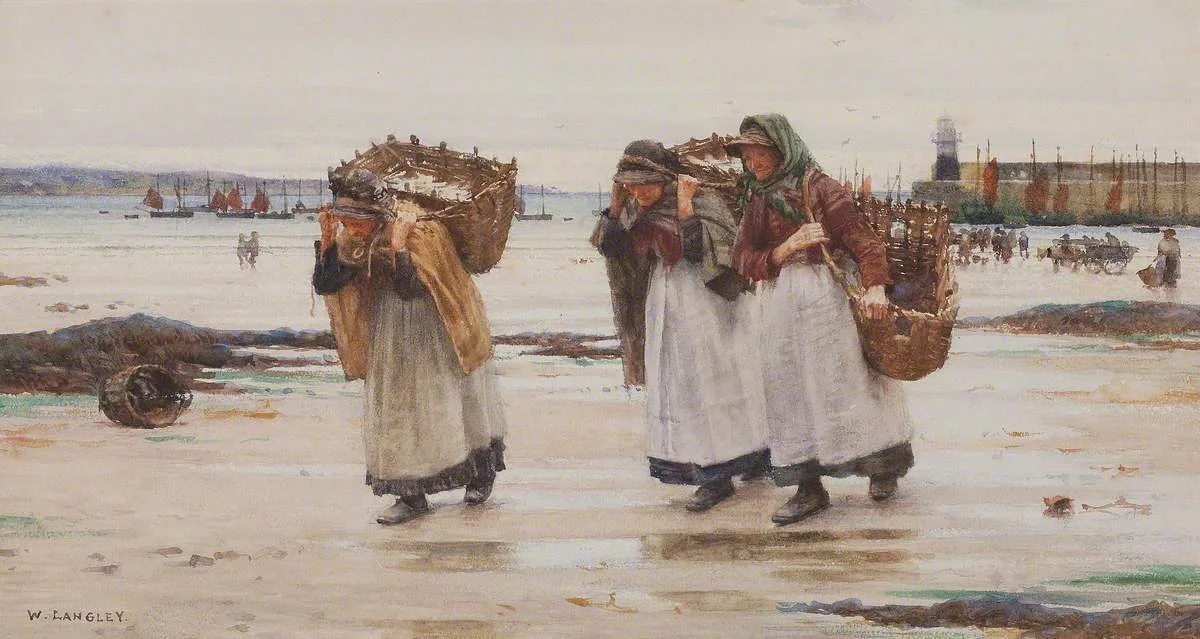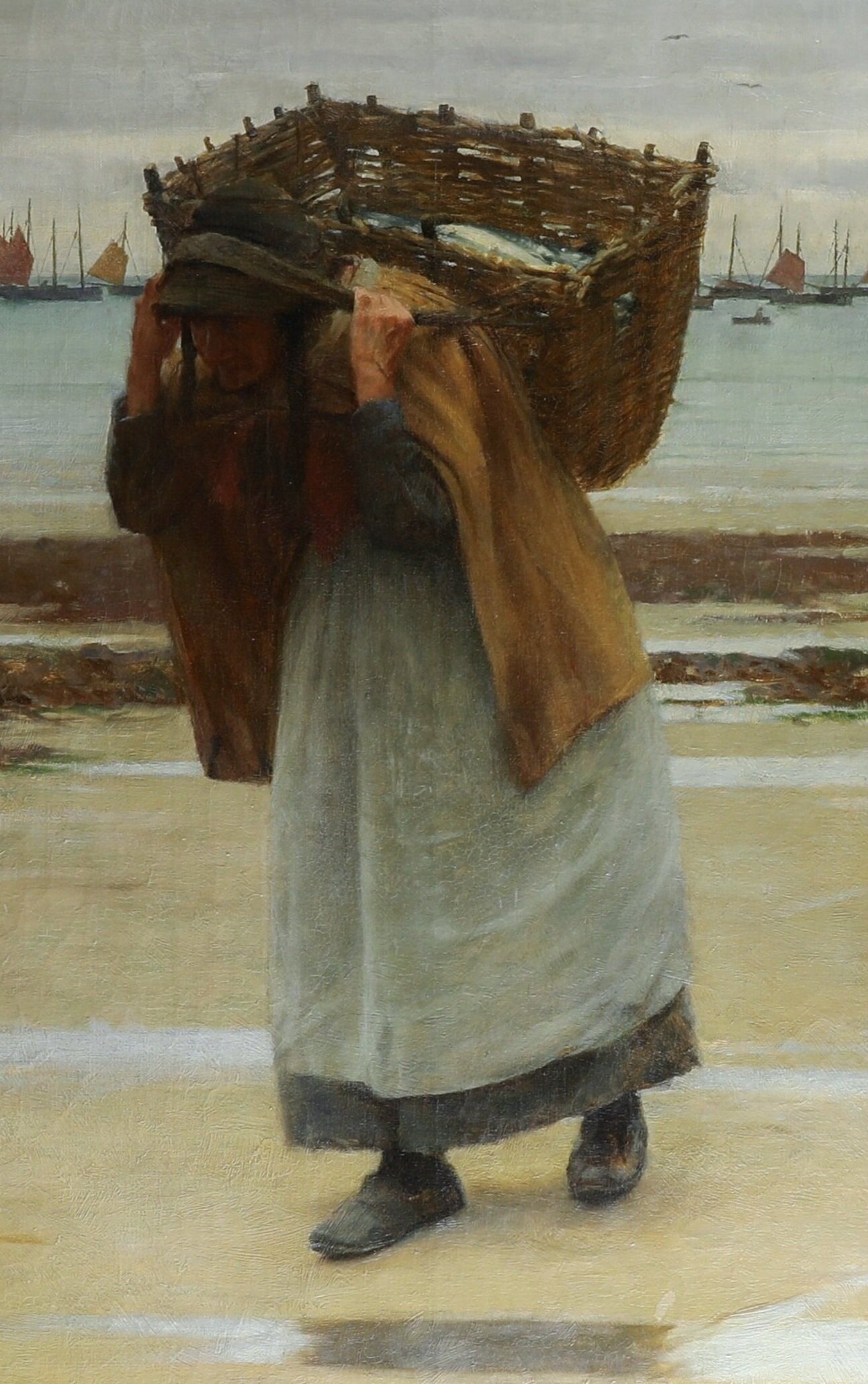‘The Breadwinners’ by Walter Langley
Before treatment
After treatment
This painting is a wonderful example of the work of Walter Langley (1852-1922), who is remembered as the founder of the Newlyn School of plein air artists and for his social realist portrayals of working class figures in the local community. At over one meter tall and more than 2 meters wide, this picture gives monumentality to the working women depicted, expressing Langley’s sympathy with the local fishing community in Newlyn.
The painting shows three elderly women carrying baskets of fish along the beach at Newlyn at low tide, with fishing boats visible in the background and other fisherfolk gathered on the beach; a horse-drawn cart and the end of Newlyn’s South Pier are visible in the background to the right. This pier with its distinctive lighthouse often appeared in Langley’s works, as in the two examples below, and can still be seen today.
A view of South Pier nowadays.
Langley’s medium of choice was watercolours and he was a prominent member of the Royal Society of Painters in Watercolours, but in the period before painting this scene he had come to feel that oil paintings attracted more attention at the Royal Academy, which seems to have influenced his decision to paint a monumental work in oil on canvas for submission to the RA. Langley exhibited this oil on canvas work at the Royal Academy in 1896, where the picture was hung prominently at eye level, and well received. The Morning Post’s critic praised Langley’s, '... realism and truth to atmospheric effect that manifest at once the keenness of his observation and the practised skill which guides his hand.' Langley also produced the same scene in two watercolours, one a study for the right hand figures (43 x 59 cm) and the other showing the full composition (47 x 62 cm) which is now in the Penlee Museum’s collection.
Langley’s watercolour study of two of the figures
Langley’s watercolour of the full composition
The title ‘Breadwinners’ reflects the harsh reality of daily life for the local women in the fishing community and pays tribute to their endurance. While men faced injury and death from shipwrecks and other dangers associated with fishing, the situation was not rosier for women, who sold fish in order to earn money with which feed their families. Even into old age, women had to persevere with the backbreaking work of carrying heavy sodden baskets, worn with a strap across the forehead, laboriously walking from the beach at low tide into town and beyond. Langley has chosen to depict the women in colours closely relating to the sea and rocks among which the women walk, showing their close connection to the natural environment.
The painting was recently acquired by The Bowerman Charitable Trust, who contacted Simon Gillespie in order to have a formal assessment of the condition of the picture and a treatment proposal in order to bring the picture back to looking its best.
On assessing the picture, Simon observed that the picture had been treated relatively recently, perhaps in the last 50-30 years, when a partial removal of some of the discoloured old varnishes was carried out, a new varnish applied, and some retouching added in an imprecise manner. At some point in its history, the areas of lighter coloured paint in the picture had been cleaned quite harshly, causing some abrasion to the original paint. On the other hand, a discoloured slightly opaque varnish layer had been left on the areas of dark paint, where it was causing pronounced shiny patches in reflected light but also creating a visual imbalance between light and dark areas in the picture and having a flattening effect on the depiction of details in the areas of darker paint such as the women’s upper clothing. The overall colouring in the picture was slightly subdued by the recent varnish which had discoloured to a slightly grey/yellow colour. The retouching was especially noticeable in the sky and its presence confirmed by looking under ultraviolet light which showed broadly applied strokes of retouching, probably applied to areas of thinness in the original paint caused by abrasion during past amateurish cleaning.
The painting viewed under UV before treatment. UV confirms that the painting had been selectively cleaned in the past, removing a discoloured, dull opaque varnish from areas of pale-coloured paint only, leaving varnish on the areas of dark paint. This leaves a slightly patchy image, the lights are bright but the darks lack detail.
One of the fascinating aspects of this picture was that there were areas where it was possible to see that in the course of painting this work, the artist had changed his mind about the placement and scale of some of the elements in the composition. A real insight into the artist’s mind at work! It was possible to see these because the uppermost paint layer had gradually become slightly translucent over time (as oil paint naturally does), revealing a ghostly shape of the artist’s earlier composition beneath. For example, the artist had originally painted the lighthouse on the end of the pier on a much larger scale: it can be seen on close inspection as a slightly darker domed shape in the sky behind the lighthouse. Similarly, the boats that are lined up in front of the pier were originally painted bigger and taller, and it is possible to see the vertical strokes of their masts in the sky above the pier. These ‘pentimenti’ (that is the name given to a visible trace of earlier painting beneath a layer or layers of paint on a canvas or panel) are also visible in UV light.
Pentiment showing where the artist changed their mind about the size of the lighthouse
Pentiment of taller masts in the sky above the pier
UV light shows the pentimenti of the lighthouse and masts
Continuing the assessment of the picture and its condition: the structure of the painting was sound. In severe reflecting and raking light, there was a pronounced disrupted surface of raised cracks in the structure of the paint, caused by fluctuations in relative humidity in the environment where the picture had previously been housed: perhaps it had been hung on an external wall or in a slightly damp room. The cracks were to be found in the areas of the canvas that are not protected by the buffering effect of the stretcher bars on the reverse. There was therefore a slight impression of the stretcher bars where there were no cracks. The absence of cracks in the parts of the canvas that had been protected by the stretcher bars demonstrates how important it is to have the reverse of canvas paintings covered with a backboard to buffer against changing humidity levels.
On closer inspection there was also a further network of very fine drying cracks; these were most noticeable in the areas of dark paint and were showing the white preparation layers beneath the paint. Some of these had been artistically retouched by an amateurish restorer and the retouching was slightly inaccurate, covering original paint.
Detail of the texture of the painting before treatment
Detail of the texture of the painting after treatment
The painting viewed from the reverse before treatment. The dark lines visible on the reverse of the canvas show where varnish applied to the front of the picture has penetrated the cracks in the paint and has stained the canvas.
The cracking pattern in ‘The Breadwinners’ was very similar to what we had observed in this large 17th century Venetian picture that we treated a few years ago. From the pattern of cracking, we can deduce that the painting had been hanging on a wall that was susceptible to damp. In the detail photograph (right) you can see that the paint is not cracked on the left and top of the photograph, which is an area that had been isolated from any dampness in the wall by the wooden bars of the stretcher frame onto which the canvas is stretched, whereas in the other areas the canvas had no such buffer and therefore the fluctuations in relative humidity had caused the canvas to expand and shrink repeatedly over time. Because the paint does not expand and contract with the canvas, the movement of the canvas causes stress to the paint layer, resulting in the formation of cracks. This is why we recommend the application of a backboard to artworks: the backboard creates a buffer that protects the canvas and therefore the paint layer, mitigating the effects of environmental changes.
‘Venice, the Doge in the ‘Bucintoro’ departing for San Nicolò al Lido on Ascension Day”, by Alessandro Piazza (c. 1665-1727), oil on canvas, 145 x 200 cm.
Detail of the top left corner of the painting, showing a distinct vertical strip on the left and horizontal strip at the top where the paint layer is not cracked, corresponding to the wooden stretcher frame on which the canvas is stretched.
The ‘Breadwinners’ painting was unlined, and there was a slight lack of tension in the canvas. Viewing the picture from the reverse, Simon observed that the wooden stretcher was broken at all four corners, making it unsafe.
Detail of one of the corners of the wooden stretcher frame which was broken
On the basis of his assessment of the condition of the picture, Simon put together a treatment proposal, which was sent to the owners. We received approval from the owners to proceed, and treatment began. Firstly, the painting was removed from its frame and surface cleaning was carried out including dry dusting to remove loose surface dirt from the front and back of the canvas. After testing to tailor-make an appropriate, safe and effective cleaning solution, the various uneven varnish layers were carefully removed as well as the past retouching. This process revealed the artist’s original paint layer. It also revealed the areas of slight abrasion that the painting had suffered through past harsh cleaning treatments, and the light drying cracks that had naturally occurred as the oil paint dried over time.
The surface cleaning in progress, showing the yellow film of surface dirt in process of being removed from the painting
The canvas was then removed from its stretcher and treated under controlled conditions to bring the areas of cracked paint into plane. We had a new stretcher made. The edges of the original canvas were strengthened in a process called strip-lining, whereby a narrow strip of canvas is adhered to the edge of the original canvas to add strength to the edge in order to allow us to then attach the canvas onto its new stretcher and tension it.
The painting undergoing treatment to resolve the cracking of the paint
Pinpoint retouching was then carried out to the areas where the paint was abraded, and some of the small networks of drying cracks were reduced with pinpoint retouching to an acceptable level. A final thin semi-matt protective varnish was applied. The picture was then secured back into its frame.
A detail of the painting seen in UV light before treatment: retouching is visible as dark strokes in the sky, and the area of the women’s clothing in the shade and of the baskets is cloudy from past varnishes that have been left on.
A detail of the painting seen in UV light after treatment: cleaning to remove the retouching revealed that a fair bit of retouching had been applied unnecessarily covering original paint. Our team was able to be much more precise in applying retouching only to the areas of actual damage to the original paint. Through cleaning to remove the layers of discoloured varnishes, much greater depth and detail was revealed in the women’s faces, clothing, and baskets.
A detail of the painting before treatment in normal light
The same detail after treatment in normal light
A detail of one of the figures after cleaning to remove the old discoloured varnish and overpaint that had been inaccurately applied to cover up cracks in the original paint layer
A detail of the same figure after treatment, where precise retouching has been carried out to reintegrate some of the areas of cracks.
The picture was delivered to The Bowerman Charitable Trust at Champs Hill in the south of England, and we received the following lovely email: ”Breadwinners arrived yesterday to gasps of astonished admiration. So grateful to you all for your work on our behalf.” It was unveiled during the Trust’s spring 2022 exhibition ‘Classic Newlyn (1880-1910)’. Simon had the pleasure of speaking at the opening of the exhibition, giving a presentation about the treatment process.


























